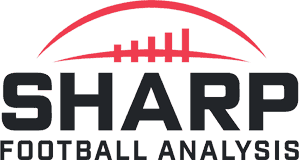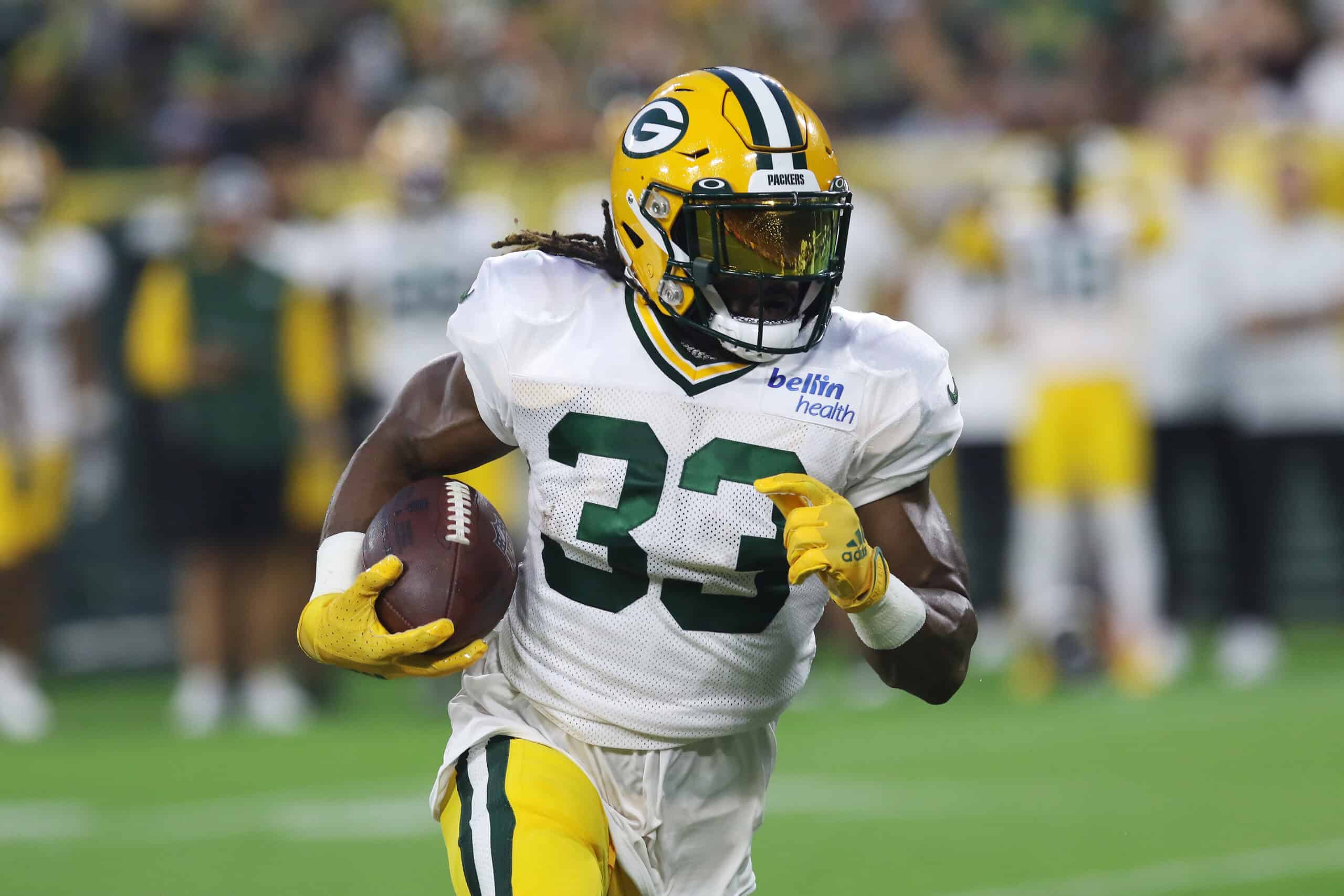The Worksheet, a fantasy football overview by Rich Hribar, breaking down everything you need to know for the Week 1 Green Bay Packers at Minnesota Vikings Sunday afternoon game.

Green Bay Rank @ Minnesota Rank -1.5 Spread 1.5 25 Implied Total 23.5 25.6 10 Points/Gm 25 13 21.3 10 Points All./Gm 25.1 24 62.6 18 Plays/Gm 63.7 13 60.5 5 Opp. Plays/Gm 67.8 31 5.8 9 Off. Yards/Play 5.7 12 5.3 13 Def. Yards/Play 5.7 26 41.39% 16 Rush% 41.46% 15 58.61% 17 Pass% 58.54% 18 38.93% 6 Opp. Rush % 41.23% 13 61.07% 27 Opp. Pass % 58.77% 20
- 64.7% (11-of-17) of the Minnesota games went over the game total in 2021, the highest rate in the league.
- The Vikings (77.3%) and Packers (73.6%) were second and third in the NFL in rate of touchdowns that came via passing in 2021.
- The Vikings (6.8%) and Packers (6.9%) had the two lowest rates of turnovers per possession in 2021.
- The Packers have won seven straight games without Davante Adams in the starting lineup, averaging 31.6 points per game in those games.
- Minnesota ranked 31st in the league in the percentage of drives allowed that failed to gain a first down or touchdown (25.8%).
- Minnesota was last in the league in expected points added via their rush defense in 2021 (-44.6).
- 87.8% of the rushing attempts against Minnesota gained positive yardage, the highest rate in the league.
Quarterback
Aaron Rodgers: Rodgers has won back-to-back MVP awards while finishing as the QB4 and QB7 in fantasy points per game the past two seasons. Rodgers closed the 2021 season on fire, with six straight top-10 scoring weeks.
Rodgers has played 10 full games (excluding season finales) without Adams available over the past six years. In those 10 games, Rodgers has posted six QB1 scoring weeks with just one week lower than QB15, averaging 21.9 fantasy points per game.
While the floor has been strong, Rodgers has found it harder to access his week-winning ceiling in those games, posting just three weeks higher than the QB7 with three top-three scoring weeks in that 10-game sample.
While an elite ceiling has been harder for Rodgers to access without Adams, we also do not want to overweight the limited sample here with Adams off the field. It is one thing to recalibrate for a week or two in a season and carry production, but another now to do so for a full season with a receiving unit that does not inspire a ton of confidence.
We are just two years removed from Rodgers checking in as the QB14 in points per game and the field questioning a potential decline.
This Packers offense could be much more conservative with all of the moving parts in the receiving corps, and this Green Bay offense was already last in the NFL in time of possession per play in 2021 (31.4 seconds). If the Minnesota run defense is not improved compared to 2021, this could be a heavy dose to the Green Bay backs paired with Rodgers’s strong keep-away nature in not turning the ball over.
Rodgers has dusted the Vikings up for 26.8 points per game in four outings the past two seasons, throwing 13 touchdown passes and zero interceptions in those games. Of course, he had Adams for all of those games (and Adams had games of 14-156-2, 7-53-3, 7-115-2, and 11-136-1) while the Vikings have made wholesale changes this offseason in terms of staff, with Ed Donatell taking over as defensive coordinator.
Donatell was with defensive coordinator for the Broncos the previous three seasons. We should be expected to see a lot of quarters and Cover 6 principles come with him, something we had seen in the preseason. In the exhibition period, the Vikings were in those looks for a league-high 41.2% of passing snaps while in zone coverage on 76.0% of snaps (fourth-highest). The only thing here, is this is nearly the exact same structure that Rodgers is facing in practice as Green Bay runs a very similar scheme under Joe Barry.
With Green Bay sporting a high team total and only four other games having a higher game total than this one in Week 1, Rodgers is squarely on the floor as a QB1 option, but there is added volatility. It will ultimately come down to how comfortable Rodgers is with these wideouts early in the season and how aggressive the Packers are offensively. Those two things will drive just how efficiency-dependent Rodgers needs to be for fantasy output.
Kirk Cousins: Cousins has always taken a lot of flak for his ceiling in altering a franchise, but he has been a steady fantasy producer, closing just one of the past seven seasons outside of the top-16 scorers at his position per game while finishing as the QB12 in points per game in each of the past two seasons.
Not only does Cousins have attachment to arguably the best wide receiver in the NFL, but Minnesota has been an offense we have been circling for fantasy production despite the fact that they were often playing handcuffed by an archaic offense approach. That is going to change now under Kevin O’Connell, providing a runway for an offense to reach new heights for fantasy.
O’Connell comes from a system that has ranked fourth in early down pass rate (56.4%) in neutral game script over the past two seasons with O’Connell as offensive coordinator while Minnesota has ranked 26th (49.0%) over that same span.
36.9% of Cousins’s pass attempts came on first down in 2021, which ranked 27th in the league. The only quarterbacks to have more pass attempts on non-first down plays needing seven or more yards to gain a year ago were Tom Brady and Matt Ryan. 28.9% of Cousins’s pass attempts a year ago came on third down, which was the third-highest rate in the league.
While this offense may not have an overly dramatic shift in overall passing volume or raw pass attempts compared to the output Cousins and Minnesota had a year ago, it is an offense that is going to put him in far more favorable conditions for success.
Cousins only made one start against the Packers a year ago, but he found plenty of success, closing as the QB5 (25.2 points) in a 34-31 shootout. The Packers did not have Jaire Alexander available in that game as food for thought while the Packers can always slow any game way down and limit plays. That said, Cousins is one of the more appealing QB2 options for game environment and offensive attachment.
Running Back
Dalvin Cook: Despite 1,383 yards from scrimmage, Cook averaged a career-low 4.9 yards per touch in 2021 and closed the year as the RB11 in points per game.
Cook still was fifth in the league in touches per game (21.8), but what hurt him was finding the end zone just six times after 17 and 13 scores the previous two seasons, while he averaged a career-low 2.6 receptions per game for just 6.6 yards per catch.
New head coach Kevin O’Connell not only brings in a system that could help Cousins and this passing game, but one that should harness a bounce back for Cook as well.
The Los Angeles backfield (O’Connell’s previous stop) was not littered with target earners, but the combination of Darrell Henderson (104 routes) and Sony Michel (79 routes) ran 183 pass routes in the slot or lined up out wide. Dalvin Cook ran just 35 of those routes in 2021.
That can be a big aid in generating more explosive plays in the passing game from Cook, who is coming off a career-low 2.6 receptions per game for just 6.6 yards per catch, never reaching that holy grail of 4.0 per game while they have dipped in each of the past two seasons from the season prior.
Even without a major influx of receptions, the system change is going to aid Cook on the ground.
We have already seen that this will be a heavy 11 personnel driven offense under O’Connell. Minnesota used 11 personnel on 74.8% of their snaps in the preseason after a 42.1% rate in 2021. 62.3% of their run plays in the preseason were out of 11 personnel (eighth) after just a 24.3% rate (30th) in 2021.
Since Cook entered the NFL, he ranks just 29th among running backs in carries out of 11 personnel (just 27.5% of his career carries are from 11). But his efficiency when having more wideouts on the field and subsequently seeing lighter boxes shines. He ranks seventh in yards per carry from 11 (5.4 YPC), and fourth in EPA per rush (0.06). Over the past three seasons, Cook is fifth, seventh, and first in EPA per rush from 11 personnel.
Cook is back on the board as a front-end RB1 due to these changes, but we do want to see early confirmation on having an expanded receiving role compared to a year ago.
The Packers were a mid-pack run defense in 2021, allowing 4.28 yards per carry to backs (16th), but faced the third-fewest rushing attempts per game a year ago due to game scripts and the low volume of plays that opponents ran altogether.
Packers RBs: Aaron Jones closed 2021 as the RB13 in points per game, but his season was an overall mixed bag than previous years.
On the pro side, Jones has scored double-digit touchdowns in three consecutive seasons. The only other player to do so has been Derrick Henry.
He remained efficient, averaging 5.3 yards per touch, his fifth straight season over 5.0 yards per touch. He caught another 52 passes, which was sixth among backs (12th in receptions per game). In the playoffs, Jones showcased his upside with 170 yards on 21 touches in the Divisional Round.
Jones has always relied on efficiency over volume, and his 14.9 touches per game checked in 21st among backs as we progressively saw more of A.J. Dillon as the season wore on. Jones picked up a knee injury in Week 10, but even prior to that, had posted just three RB1 scoring weeks with Dillon ramping up.
After Jones returned to the lineup in Week 12, Dillon received 17 red zone opportunities to just five for Jones when the two played together with Dillon having a 9-to-3 edge inside of the 10-yard line over those games.
That is significant because touchdowns have been a massive part of Jones’s game for fantasy. When Jones has failed to reach the paint, his volume discrepancy versus his peers shows up.
Jones is averaging just 7.2 PPR points and 6.2 0.5 PPR points per game over his career in 33 games without a touchdown. Those totals are lower than backs such as Devin Singletary and Miles Sanders. They are also lower than his backfield running mate A.J. Dillon over his small sample of games played.
Jones has never had an RB1 scoring week without a touchdown while producing an RB2 week or better in just 24.2% of his games without a touchdown, a rate that ranks 20th among all top-40 backs in current ADP and tied with Singletary.
Now, Jones has a runway to raise his receptions per game for a sixth straight season with the trade of Davante Adams paired with the Packers not bringing in a career target-earner at the wide receiver position.
In the seven games that Adams has missed over the past three seasons, Jones has received 6.7 targets per game (19.7% of the team share), with 5.1 catches for 55.4 yards per game and four receiving scores. In 2021 with Adams, Jones ranked seventh among running backs with 78 routes run from the slot or out wide, while being targeted on 25.6% of those routes.
After just 48 touches as a rookie, Dillon took advantage of the exit of Jamaal Williams, ballooning up to 221 touches for 1,116 yards and seven touchdowns in his second season.
I already mentioned Dillon’s extended role in the red zone with Jones above, but Dillon also showcased that he could catch the ball as well, securing 34-of-37 targets (for 9.2 yards per catch) after catching just 21 passes in his collegiate career.
We are anticipating this being a 1A/1B situation on a team that could inherently want to lean on their backs and playing clean football behind Rodgers to win games, but early in the season we are looking for clarity on the usage of these backs.
We know Jones has receiving upside, but does he have a grasp on money touches in the red zone? Does Dillon only become a touchdown dependent FLEX with contingent upside without Jones playing, or does he elevate into something greater?
This should be a matchup to give both backs plenty of work as Minnesota was 23rd in rushing points allowed to backs (14.5) and 20th in receiving points allowed per game (10.0) to backfields.
With a somewhat cautious approach, I am handling Jones and Dillon in the same capacity that was reflected in their ADP this summer, with Jones as a back end RB1 and Dillon as a fringe RB2/FLEX, but the ceiling potential for Jones should he reclaim activity near the end zone makes him the more alluring DFS option in game stacks of this game.
Wide Receiver
Justin Jefferson: Jefferson followed up an 88-1,400-7 rookie season in which he was the WR9 in points per game (17.1) to post 108-1,616-10 this past season as the WR4 in points per game (19.4). Only Randy Moss (607.4) has scored more PPR fantasy points through two seasons than Jefferson has (604.6) while the player in third place is nearly 100 points behind both of them.
Jefferson had a gaudy 8-169-2 line in this matchup a year ago with Kirk Cousins playing in Week 11, followed by a 6-58-0 line playing with Sean Mannion in Week 17.
It is worth mentioning that Jaire Alexander did not play in that Week 11 matchup, while Jefferson managed a pedestrian 3-26-0 line in their 2020 matchup. In that game, Jefferson had just one catch for 12 yards while Alexander shadowed him on 79% of his routes.
Now, we are not moving off Jefferson as a WR1 in fantasy based on any individual matchup, it just plays a role in volatility that could go into DFS rostership.
That game came when he was a rookie and in a different offense. Jefferson has already shown that he can win inside and outside at the NFL, but an increase in freeing him up more while reducing his isolated routes can blow the lid off of the skill set we have seen from Jefferson to this point.
The Vikings may not have an absurd spike in passing volume under Kevin O’Connell, but the diverse usage of the route tree for fantasy-friendly routes and an aggressive nature in situational passing is a major upgrade over the previous regime. Our own Dan Pizzuta highlighted how the climate of the new system in Minnesota can still take a player with an all-time great start to his career to another level.
Adam Thielen: Thielen averaged a career-low 10.8 yards per catch, but he remained one of the best touchdown-or-bust fantasy options, scoring 10 times over 13 games before an ankle injury cut his season short.
Thielen will turn 32 this August, leaving those gamers still holding him to hopefully make one more touchdown-driven drive into the sunset.
Last year, Theilen turned 53.9% of his red zone targets into touchdowns, the highest rate among all players with double-digit opportunities. League rate was 27.2% among those players. On end zone targets, Theilen caught seven of eight for scores (87.5%), leading the league in conversion rate on those targets. League rate was 39.9% on those targets. Over the past two seasons, Theilen has converted a blistering rate of 20-of-28 end zone targets.
Can O’Connell’s system give Theilen more pulse than being a touchdown-dependent WR3? Minnesota still has a thin roster at the position.
The Packers were a stingy defense overall in 2021 to opposing wideouts, even with Alexander missing so much time. Opposing wideouts caught just 57.6% of their targets (third lowest rate) for 7.4 yards per target (eighth), but wideouts turned 5.5% of those targets into touchdowns (10th highest), which lines right up with how Theilen has been as a fantasy asset the past two seasons.
K.J. Osborn: Osborn chipped in a productive season in his second year in the league, catching 50 passes for 655 yards and seven touchdowns in 2021.
We have already highlighted the use 11 personnel expected in this offense throughout, which will make Osborn close to a full-time player on offense. Osborn ran a route on 78% of the team dropbacks last season and just 70.4% of the dropbacks when Adam Thielen was available.
The matchup itself is not overly appealing to elevate Osborn as more than a FLEX bet but does give him more life in game stacks for those targeting this game overall.
Packers WRs: With the trade of Davante Adams, this passing game is forced to operate in a very different way moving forward. It is one thing to bridge a game or two missing Adams within the context of a season, but fully preparing to operate without Adams overall for an entire season is a much different task.
Adams had 109 more targets in 2021 than the next closest wide receiver on the roster. Overall Adams accounted for 29.6% of the team targets, 30.6% of the receptions, 34.3% of the receiving yardage, and 28.2% of the touchdown grabs on this roster.
The team is expected to run out the trio of Allen Lazard, Sammy Watkins, and Randall Cobb as the primary set of wideouts , but a strong preseason from rookie Romeo Doubs will likely draw him immediate playing time while Christian Watson gets worked in.
Lazard would easily be the player here to be most comfortable with using in lineups in Week 1 as a WR3/FLEX if he’s good to play, but LaFleur said that he is dealing with an undisclosed injury and could be in question for Sunday. Lazard has not practiced through Thursday and gamers should move in another direction activating that he will not be a full go Sunday, even if active.
While we should see all of Watkins, Doubs, and Watson draw snap on the outside, Cobb is the one player here who should not have much competition as he is the one player that can play in the slot. Cobb had four games last year in which he received five or more targets, and in those games, caught five touchdowns. Cobb was 24th among wide receivers in expected points inside of the red zone, so there is some deep touchdown chasing potential.
Watkins has not cleared 673 yards in a season since 2015 and we did not see him play in the preseason. You, of course, are aware that Watkins has made it a habit of showing up at his best to start the season, posting games of 4-96-0, 7-82-1, and 9-198-3 over the past three Week 1 games.
Doubs is the most exciting of these options since we have been down the road with both of the veterans, we just do not know how much he will actually play.
Coming out of the vertical passing game in Nevada, Doubs turned in back-to-back 1,000-yard seasons with 20 touchdowns the past two seasons. This preseason, Doubs was targeted on 38.5% of his routes, catching 8-of-15 targets for 82 yards and two touchdowns.
With the sheer loss of vertical targets absent from Adams and Marquez Valdes-Scantling, Doubs should be a rotational player early to fill in some of that void and could outright be forced into an actionable role should the Packers be missing Lazard.
If Lazard is out, that makes Watkins and Doubs more intriguing DFS and game stacking darts with Cobb as a touchdown or bust play, but all of these guys still require a significant step of faith for lineups outside of FLEX swings.
Tight End
Irv Smith Jr.: We still do not know what we have in Smith Jr. as he missed all of 2021 due to a meniscus injury. He missed the entire preseason with a thumb injury but is on track to play in Week 1.
Smith is just 24 years old and took a step forward in his second season, upping his yards per catch from 8.6 to 12.2 in 2020 while scoring five times after twice as a rookie.
Green Bay did allow some production to tight ends in 2021, surrendering a 73.3% catch rate (28th), 7.3 yards per target (16th), and a 6.7% touchdown rate (26th) to the position to give Smith Jr. a pulse as a TE2 and DFS option.
Robert Tonyan: The Packers were at the bottom of the league in output from their tight ends in 2021 without Tonyan, with the group ranking 23rd in targets per game (5.6), 20th in yards per game (43.1), and 26th in touchdowns (four).
Tonyan is recovering from an ACL injury, coming off the PUP list on August 14, but Matt LaFluer has been committal that he will be 100% ready to go for the season opener. That alone leaves him as someone to leave on benches to start the season until we see him back as a full-time player.

More Week 1 Fantasy breakdowns from The Worksheet:
BUF at LAR | NO at ATL | CLE at CAR | SF at CHI | PIT at CIN | PHI at DET | IND at HOU | NE at MIA | BAL at NYJ | JAX at WAS | KC at ARI | GB at MIN | NYG at TEN | LVR at LAC | TB at DAL | DEN at SEA
















